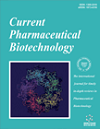-
oa Editorial [Hot Topic: The Era of -Omics (Guest Editor: David M. Pereira)]
- Source: Current Pharmaceutical Biotechnology, Volume 13, Issue 5, Apr 2012, p. 623 - 623
-
- 01 Apr 2012
- Previous Article
- Table of Contents
- Next Article
Abstract
In the last few years we have observed a revolution in several branches of science, with many new areas of study being born. In this issue we will have insights in some hot topics in the area of -OMICS and their contribution in translational medicine and human health. Cardiovascular disorders constitute the leading health problem and cause of death in developed countries. In the past few years, the use soy and its derivatives as an approach to prevent and control the onset of the disease has been increasingly popular and, for this reason, epidemiological, clinical and -omics perspectives on soy isoflavones and cardiovascular disease will be reviewed by Gil-izquierdo et al. Next to cardiovascular disorders, cancer is the second most prevalent health condition and is frequently is associated with high mortality. The work by Pereira et al. will discuss the contribution of metabolomics in drug discovery by reviewing the major classes of drugs from vegetable origin in clinical practice. Unfortunately, the area of cancer chemotherapy is well aware of the problem of drugs resistance and, in this regard, Rodrigues et al. will review the contribution of genomics to cancer drug resistance, an area of knowledge that may be vastly important in a near future with the onset of personalized medicine. Central nervous system disorders constitute the third problem of health in developed countries, after the above-referred ones. Given the alarming abuse of psychotropic drugs, as well as the inappropriate response of most patients, new approaches are urgent. In this matter, the seminal work by Cacabelos et al., will address the genomics and pharmacogenomics of brain disorders. Apart from the traditional areas of OMICS, namely genomics, transcriptomics, proteomics and metabolomics, several new areas of research have been paving their way in the last few years. Such is the case of lipidomics, the study of lipidome (the totality of lipids in cells, organs or organisms). In this area, we count with two most important contributions. Cecile and co-workers will address non-alcoholic steatohepatitis, the most common liver pathology characterized by fat accumulation in a context of metabolic syndrome or insulin resistence. This area has been subjected to several studies in the past few years and the major conclusions and future directions are presented. Still in the area of lipidomics, Quinn et al contribute with an unavoidable work that reviews the application of lipidomics to assess lipogenesis in drug development as well as pre-clinical trials, covering all topics from the methodological steps to data handling and interpretation. Serino and colleagues will review the contribution of “-omics ”to the assessment of gut microbiota-driven metabolic modifications of the host. In their work on Microbiomics, they will discuss how new methodologies can help to understand the complex interactions between host and gut microbes. Overall, I hope this special issue constitutes an elucidative state of the art for some hot topics in the ever growing areas of – OMICS sciences.


